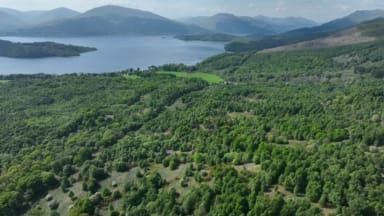
Situated on the banks of Loch Lomond in the heart of the Trossachs National Park, the estate has been in the care of the Cashel Forest Trust since it was created from a bracken-strewn wilderness in 1995. Cashel contains one of the largest, and oldest, of the ‘new’ native woodlands in Scotland – 300ha of native tree including oak, birch, ash, aspen, alder, gean, hazel, holly, juniper, willow and Scots pine – alongside significant areas of ancient oakwood.
Cashel comprises of hillsides, moorland and native woodlands, rich in natural assets and offering significant potential for carbon and biodiversity-based projects. The estate is managed as a native forest with public access encouraged, along with forestry education activities. Extensive areas of the open hill are managed for peatland restoration. The Cashel Burn generates sustainable electricity for the national grid. The abundance of wildlife at Cashel is remarkable, with resident badgers, red, roe and occasionally fallow deer, adders, red squirrels, pine martens, otters, water voles, and a diverse array of birds. The trust is dedicated to nature conservation, fostering ‘wildlife corridors’ connecting the Loch Lomond and Loch Ard catchments.
Cashel Forest Trust was set up in 1996 when they took ownership of the Estate. The primary objective of the purchase was to demonstrate the restoration and regeneration of Scotland’s native woods through sound forestry practice, for the benefit of the public. The Trust is run by volunteers who have considerable knowledge and experience in woodland creation, land management and conservation.
The oak woods of Loch Lomond have a long history and represent some of the largest remnants of semi-natural woodlands in the country. In the 18th century, the woods were systematically managed and converted to oak ‘coppice-with-standards’ with the smaller timber managed for bark, leather tanning and charcoal. The larger timber used for boat building, more general domestic and estate use. There is about 24 hectares of remnant oakwood at Cashel.
Between 1997 and 2001, the current owners undertook a programme of native species planting, mainly on the lower slopes. Mixed broadleaved species including Oak, both sessile and pedunculate and birch with scattered groups of ash, aspen, alder, gean, hazel, holly, juniper and willow were successfully established. Scots pine was also planted on suitable sites and there is now an opportunity for thinning. Montane scrub, a very limited resource in Scotland which offers excellent support for biodiversity, has been planted on parts of the extensive moorland. There is additional scope for further tree planting and to expand the woodland area by natural regeneration. In general, these important woodlands are managed on a non‐commercial basis, for the benefit of conservation, leisure and public access. At all times promoting the existing ancient/native woodland and encouraging the growth of mixed native tree species. There is an abundance of wildlife thriving from these management practises.
Much of the hill land, 845 hectares, is peatland – made up of nationally important Class 1 and Class carbon-rich soils, deep peats (maximum peat depth recorded >4.5m) and priority peatland habitat of high conservation value. In partnership with NatureScot and LLTNPA, grant funding from Peatland ACTION aided the restoration of around 80 hectares of degraded peatland during Phase 1 works in early 2024. A further circa 140 hectares of Peatland ACTION funded restoration work, Phase 2 – is scheduled to start in September 2024. The current peatland restoration project at Cashel is estimated to yield around 33,000 tCO2e in emissions reductions. The project is currently in the final stages of Peatland Code ‘Project Plan Validation’ and is expected to result in around 28,000 tCO2e of claimable emissions reductions (after deductions for the Peatland Code risk buffer). It is anticipated that further peatland restoration beyond the current works will be possible at Cashel, which could also lead to further gains of saleable peatland carbon subject to Peatland Code eligibility tests.
The owners say they are looking for a new steward for the land, which they feel they have ‘taken as far as they can’. The full estate details can be found here.

